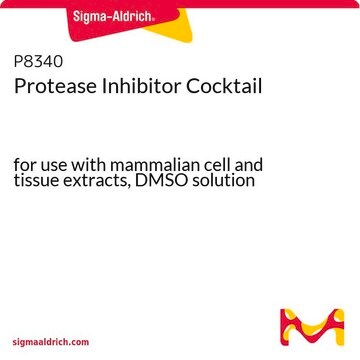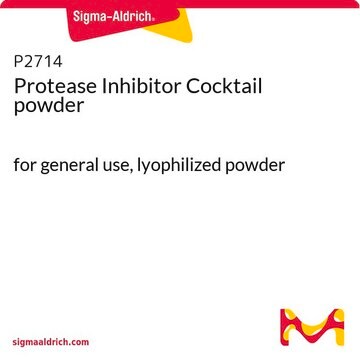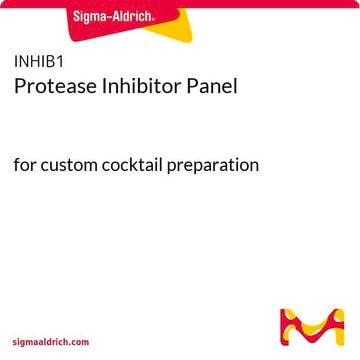Our lab has not conducted testing on the inhibition of P8465 on PreScission Protease. However, considering that the protein structure of PreScission Protease contains a cysteine nucleophile in its active site and the protein folding resembles that of chymotrypsin-like serine protease, it is likely that the inhibition is caused by ABESF and/or E-64, both of which are included in the cocktail of P8465.
P8465
Protease Inhibitor Cocktail
lyophilized powder, for the inhibition of serine, cysteine, aspartic, metalloproteases and aminopeptidases, for use with bacterial cell extracts, lyophilized powder
Sinonimo/i:
Protease inhibitor
Scegli un formato
CHF 123.00
Spedizione prevista il23 maggio 2025
Scegli un formato
About This Item
CHF 123.00
Spedizione prevista il23 maggio 2025
Prodotti consigliati
Nome del prodotto
Polvere di cocktail di inibitori delle proteasi, for use with bacterial cell extracts, lyophilized powder
Livello qualitativo
Stato
lyophilized powder
Solubilità
water: soluble
Temperatura di conservazione
−20°C
Cerchi prodotti simili? Visita Guida al confronto tra prodotti
Descrizione generale
The product contains individual components that target serine, cysteine, aspartic, and metalloproteases, as well as aminopeptidases.
Applicazioni
Azioni biochim/fisiol
Caratteristiche e vantaggi
Contains individual components, including AEBSF, EDTA, Bestatin, Pepstatin A, and E-64, each targeting specific types of proteases.
Lyophilized powder is stable for at least 2 years when stored unopened at -20°C.
Supplied with a vial of DMSO for preparation of a cocktail solution.
One mL of the cocktail solution is recommended for the inhibition of protease activity found in 20 mL of cell lysate from 4g of E. coli cells.
Avvertenza
Nota sulla preparazione
Prodotti correlati
Avvertenze
Danger
Indicazioni di pericolo
Classi di pericolo
Acute Tox. 4 Inhalation - Eye Dam. 1 - Met. Corr. 1 - Skin Corr. 1A - STOT RE 2 Inhalation
Organi bersaglio
Respiratory Tract
Codice della classe di stoccaggio
8A - Combustible corrosive hazardous materials
Classe di pericolosità dell'acqua (WGK)
WGK 3
Dispositivi di protezione individuale
Eyeshields, Faceshields, Gloves, type P3 (EN 143) respirator cartridges
Scegli una delle versioni più recenti:
Certificati d'analisi (COA)
Non trovi la versione di tuo interesse?
Se hai bisogno di una versione specifica, puoi cercare il certificato tramite il numero di lotto.
Possiedi già questo prodotto?
I documenti relativi ai prodotti acquistati recentemente sono disponibili nell’Archivio dei documenti.
I clienti hanno visto anche
Contenuto correlato
Select different protease inhibitor types based on your needs to prevent protein degradation during isolation and characterization and safeguard proteins in sample prep.
-
Does the protease inhibitor P8465 inhibit PreScission Protease? We utilized P8465 inhibitors in the purification of a GST-tagged protein fraction, and observed low activity of the PreScission protease (GE27-0843-01) on the dialyzed (using 10 kDa MWCO) GST-tagged protein fraction. Can you provide insight into the inhibition of the PreScission protease by this protease inhibitor cocktail?
1 answer-
Helpful?
-
Active Filters
Il team dei nostri ricercatori vanta grande esperienza in tutte le aree della ricerca quali Life Science, scienza dei materiali, sintesi chimica, cromatografia, discipline analitiche, ecc..
Contatta l'Assistenza Tecnica.


















